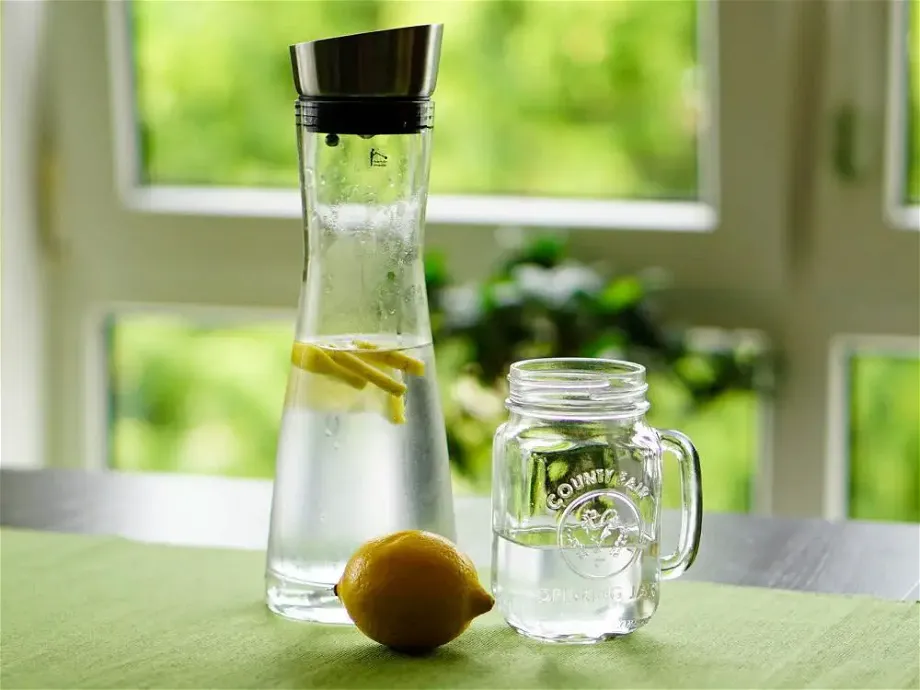 In this post, we explain why we are so concerned about water purity, how our concerns initially arose and what do we do to solve the problem.
In this post, we explain why we are so concerned about water purity, how our concerns initially arose and what do we do to solve the problem.
We all know, at least on some deep unconscious level, that water from the tap is not really that safe to drink.
Are chemicals such as chlorine and fluoride, which are added to tap water, really safe? Is the water filtered well enough before it reaches our tap? Are the pipes completely free from corrosion?
We all seek ways to access clean, potable water that is free from both bacteria and chemicals. And it is because of such doubts that the bottled water industry is on the rise today.
Post Contents
Choosing the healthier bottled water.
In so many cases, buying water in plastic bottles is our only choice.
Those plastic bottles, however, are made out of PET plastic.
PET plastic is generally regarded to be safe for one-time use. Scientific evidence suggests that PET bottles can leach toxins such as phthalates into the water as the plastic ages, gets exposed to heat or physical damage occurs.
Do not despair, though. Here is what you can do about it.
Go for the cheapest/most common brands.
The more popular or cheaper the brand is, there is a better chance for it to be fresh.
You want the water you are about to drink to have stayed the least amount of time in that bottle.
Also, buying that special brand from a spring somewhere does not guarantee you that it is actually unpolluted. Cheaper brands in many cases use tap water that is filtered and actually cleaner.
Buy from larger shops.
This is important, especially in summer.
Have you noticed that in many cases beverages are transported in open body trucks where the bottles are exposed to sunlight all day long? This is especially true for smaller shops that are not supplied with large amounts of merchandise.
Since heat can accelerate the aging of the bottle and help pollute the water inside, you would like to avoid that.
Large supermarkets tend to receive their stock during the night and in large quantities. Hence, the chance of your water to have stayed in the blazing sun for long is significantly lower.
Towards cleaner water at home
Of course, it is inevitable that while we are on the go, bottled water is in many cases the only source of clean water. Yet, we believe that we should find better sources of clean water in the environments where we spend most of the time – our home and workplaces.

Apart from it potentially being unhealthy, buying water for the home is also uneconomical and unpractical.
The easiest solution is a pitcher with a water filter.
Most water pitchers are made from higher-end plastic without BPA and phthalates which makes them a lot healthier in comparison to store bought PET bottles.
Our recommendation is to go for a glass one like the Soma Sustainable Carafe & Plant-Based Water Filter. The jug itself is made from glass and the filter is a natural, plant-based one.
Use a fixed system for best results
Pitchers may be the easiest way to filter your water but, as far as filtration goes, they are far from perfect.
Under-counter filtration systems such as this Aquasana achieve far better results. You can check our in-depth water filtration article for more info.
Clean water on the go

Water filtration systems have one main, obvious flaw – you cannot take it on the go. Yes, you can simply buy plastic water bottles but we suggest that you plan in advance.

What we can do is take glass bottles, filled with filtered water with us. It is better for so many reasons:
- since we have the quality water filtration system, the water in the glass bottles stays clean and odor-free for days;
- the water is not stored in plastic;
- it is more environmentally friendly;
The main drawback is that we need to have the bottles prepared. This means that we have to think ahead how much water will we need and actually carry them there and back again.
Honestly, in the beginning, we found these ‘complications’ a bit annoying. Yet it is the same as when we started to use reusable grocery bags – we get used to it. Today we hate buying plastic bags. And now, bottled water too.
Water at the workplace
Most offices today have water dispensers, which are ‘fed’ with water from plastic bottles. If that was not enough, have you noticed that many times these bottles are transported in open trucks, exposed to direct sunlight and heat?
What we would do to obtain the most toxin-free water at our workplace is the following:
- bring water from home in glass bottles;
- buy water in glass bottles;
- a water dispenser, which filters tap water instead of using bottled water;
- if you are in an office, where you can install a water filter, you can go for a faucet filter such as this one;
- if you cannot, go for a glass filtration jug;
- as a last resort, get a bottle with a built-in filter such as this;
What if the water at the tap is too dirty?

Generally, carbon filters are good enough to purify the water extremely well. However, if you believe that the quality of the tap water you are being supplied is very bad, then you might want to consider a reverse osmosis water filtration.
The reverse osmosis method filters everything else but the water molecules, even elements, vital to human health such as magnesium. In this way, you can get pure water even from bad water sources.
The filtration is deemed to be so good, that most higher quality filtration systems (such as this one) include a special cartridge, which remineralizes the water.
The cost

The upfront price of a water filtration system may seem steep for many. Initially, it did for us too.
When we considered the capacity of the system we chose, however, it became clear that it is actually a lot more economical. For the ~$100, we got 8,000 liters/2,100 US gallons water filtration capacity. This amount is more than what we consume in a year and certainly a lot less expensive than buying it in bottles.
The large capacity also allows us to use the water in areas, where we wouldn’t have used it before such as our steam iron/coffee machine, for example. Filtered water is soft so the pipes stay clean, which makes such appliances maintenance free.
What is your preferred way to get the cleanest water possible?



 In this post, we explain why we are so concerned about water purity, how our concerns initially arose and what do we do to solve the problem.
In this post, we explain why we are so concerned about water purity, how our concerns initially arose and what do we do to solve the problem.